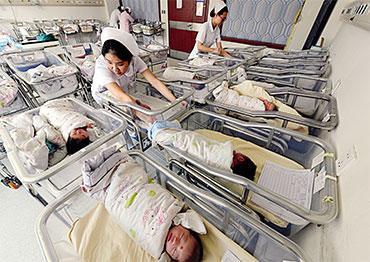Fewer births created fiercer competition among hospitals, especially for skilled obstetricians, as more women choose to have children later in life.
“The number of women who die while pregnant or in labor is an indicator of a local government’s healthcare, which is ranked worldwide,” Yu Yabin said. “Every death is discussed at a city-level conference attended by all the physicians and nurses and other people that served the woman,” she said.
To better cater to pregnant women, Yu’s hospital plans to build VIP wards that provide a hotel-grade environment and services to match.
“Over the past several decades, public hospitals focused on how to treat more pregnant women, but now the focus has shifted to how to better serve them,” Yu said. “It also meets the demands of people born in the 1990s, most of whom are only children and prefer not to share a ward with other patients,” she added.
Guantao Hospital in Hebei Province, a county-level hospital, is building VIP wards. Wang Shijun, a professor at Beijing Xuanwu Hospital, Capital Medical University, told NewsChina that his hospital is renovating its obstetrics wards and they will make staff and space adjustments according to the number of patients. He revealed that the hospital is also planning to cancel its registration quota. In China, women must register with hospitals months in advance before giving birth in case of bed shortages.
Private and public hospitals have extended their services to include prenatal care and postpartum recovery. “We found many women need prenatal consultation and treatment and we hope they remain with us,” Wang Xia said. “We didn’t do well with these services before because we had too many patients, but having fewer patients have pushed us to improve our one-stop service,” she added.
To better train staff, the Maternal and Child Healthcare Hospital of Beijing, Dongcheng District set up an exchange with Peking Union Medical College Hospital, which sends senior obstetricians to help with rare diseases and difficult cases.
Beijing Xuanwu Hospital and Guantao Hospital in Hebei opened postpartum recovery departments to treat common issues following childbirth, such as weak pelvic floor and osteoporosis. To ease women’s worries about childbirth, many hospitals are promoting epidurals.
Such improvements at public hospitals aim to take market share from private ones. Also, public hospitals are covered by social insurance, making them an even more attractive choice.
“Medical facilities need huge upfront investment and on average, a hospital will not see profits until five to seven years down the road,” Duan told NewsChina. “I think private maternity hospitals have entered the phase where competition has concentrated among existing ones, since it’s now very difficult for newcomers to survive.”
Private hospitals have to either expand their business or move to other sectors, Liu Jiangang said. He revealed that some private hospitals have launched postpartum skincare and vaginoplasty services, while others have shifted their focus to oral medicine.
“Private hospitals should shift to more academic areas and focus more on skills, though it would be a long-term process,” Duan said. “In addition, they should keep their present customers by providing excellent services. For example, they could set up expert teams to improve their existing services such as prenatal care and postpartum recovery.
“In the future, the differences in obstetrics departments at public and private hospitals may be fewer and fewer, as the former will care more about quality service and the latter will concentrate more efforts on delivery and postpartum recovery,” he added.

 Old Version
Old Version

